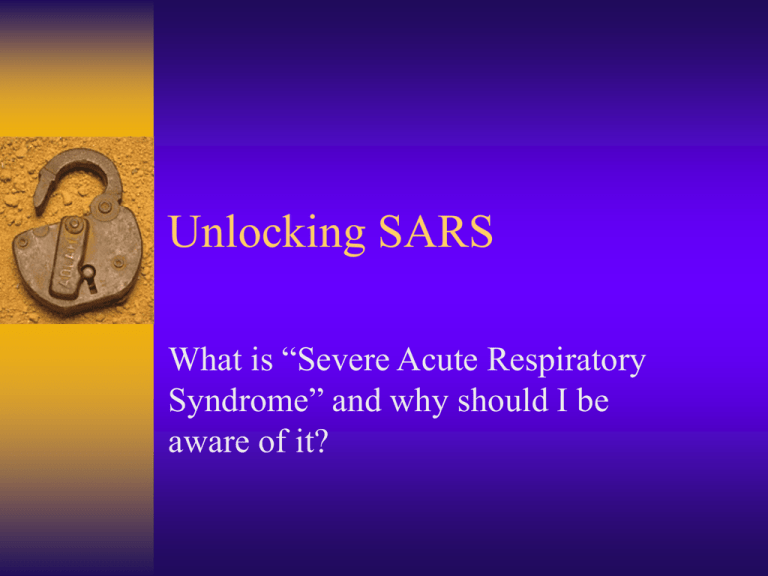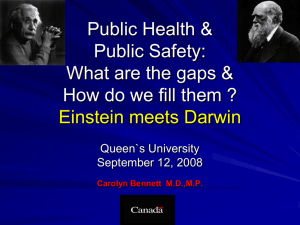Unlocking SARS
advertisement

Unlocking SARS What is “Severe Acute Respiratory Syndrome” and why should I be aware of it? SARS background SARS first appeared in China in February of this year. On about March 15th, 2003, the World Health Organization issued a “Worldwide Disease Alert” This “Alert” is unprecedented in my life time. I have never seen a “worldwide disease alert.” SARS background SARS has spread in China to at least 5 of its 10 provinces SARS has spread to Hong Kong, Singapore, Thailand, Korea, Vietnam and was spread to Canada, the US, Europe, and is now showing up in Brazil, Pakistan, and is now infecting people in about 20 different nations. SARS background The mortality rate – the proportion of people that die when infected – is about 4% To put this in perspective, the great Spanish Flu Epidemic of 1918 had a mortality rate of 2.5% In the Spanish Flu Epidemic of 1918 between 20 and 40 million people died worldwide. SARS background There is a reason why there is a “Worldwide Disease Alert” There are currently (April 16, 2003) about 3,500 people that have been infected worldwide and about 180 people have died. This does not seem to be a big problem at all to us at this time; most people are unconcerned. SARS epidemiology Mathematical models of SARS growth in the population suggests that in a very short time, some 3 or 4 months, there could be many 10s, if not 100s, of thousands of people infected if the disease continues to infect people as it has for the last month. It is not unreasonable to expect between 5k to 6k worldwide infected by the end of April, 2003. SARS epidemiology So far, of the approximate 200 people infected in the US, no one has died from SARS. But… In Hong Kong, SARS is now killing young persons, e.g., 25 to 50 years old who were apparently healthy before they were infected. There is no cure for SARS at this point. SARS epidemiology SARS is caused by a coronavirus Members of the coronavirus family that are relatives of SARS include bovine coronavirus, murine hepatitis virus, avian bronchitis virus, porcine diarrhea virus. SARS is not any of these and is a brandnew virus. There is no vaccine for SARS SARS epidemiology The viruses related to SARS suggest that it will be very difficult, in not impossible, to create a vaccine for the disease. Viruses related to SARS show that they are capable of reinfecting an animal that has previously survived an infection – there does not seem to be development of natural immunity to the virus. SARS Epidemiology Currently nations are employing quarantine procedures to isolate the sick from the notsick. There are many reports that medical staff treating patients with SARS become infected themselves. Several hundred medical staff are infected with SARS in Hong Kong. SARS epidemiology Quarantine procedures have been instituted in Toronto, Canada to deter disease spread including the closing of 2 different hospitals and several health clinics. Singapore closed its schools to all K-12 students for 15 days and, just yesterday, opened them again with concern that they may need to close them again. SARS epidemiology In the US, California, New York, Washington, Florida, and, Illinois have the highest number of SARS-infected persons. There are more than 30 now in California. SARS is, as I said, a coronavirus. It is very similar to the viruses that typically cause the common cold – but this is far more challenging. SARS epidemiology There are no vaccines for colds despite years of interest; there are no preventatives for colds; there are only palliative treatments for colds. For SARS, some Chinese hospitals have used ribavirin and steroids to help people get through the disease. SARS epidemiology Let’s assume 100 people are infected by SARS – 80 of those hundred will survive the infection just fine and have only a really-bad cold – 20 of those infected will go on to have really serious breathing problems and may require hospitalization and ventilator treatment – 4 of those 20 will die – The 20 will be in the hospital for > 10 days SARS Epidemiology What are the symptoms? – A fever of 100.5 degrees – A persistent dry cough – Malaise and body aches – Serious shortness of breath SARS is, as you probably know, highly contagious (but it is not as contagious as a flu (orthomyxovirus) virus) SARS epidemiology The SARS coronavirus can survive outside the body on a dry surface for at least 3 to 4 hours. The main vectors of infection appear to be water-droplets sprayed out when an infected person sneezes or if the fomite falls on surfaces that people touch. It can be spread by any body fluid contact SARS epidemiology It is likely that the SARS coronavirus can be airborne but not quite so infective as an influenza virus (which is also airborne transmission). There are many researchers working on ways to stop the disease right now including both the World Health Organization and the Centers for Disease Control in Atlanta, Georgia. SARS epidemiology Will these scientists be successful in stopping this disease? It is hard to say… so far, the disease appears to be spreading in an exponential fashion… the numbers infected are really going up quickly. Quarantine procedures have slowed the epidemic but have not stopped its growth SARS epidemiology Regular reports from infected nations are published on number of infected persons in each nation on a daily basis by the World Health Organization. Daily reports on the number of infected in the US are published by the CDC in Atlanta and both are available daily on the web. SARS epidemiology Is this an epidemic? – You are witnessing the beginning of an epidemic; an “outbreak” of a new disease – Numbers are growing; no cure, no very effective treatments; no vaccines – Luckily, the US has had no deaths yet; Americans have died but were in China – Canada has had 13-15 deaths – We are in the very early stages of an epidemic SARS epidemiology Will SARS become a pandemic? – A pandemic is a global epidemic – It is highly likely that it will become a global pandemic – There are reports of SARS outbreak in Africa, Bangladesh, and other places in the 3rd world – These countries do not have the sophisticated health care system that exists in the US and, once established, it will spread quickly SARS epidemiology What was the virus again? SARS virus under electronmicroscope SARS virus What is the DNA code for the SARS virus? About 27,000 nucleotides long Adenine, Cytosine,Guanine, and Thymine CDC sequenced the virus on 4/14/03 SARS virus You can view the sequence of DNA of the virus at: http://www.cdc.gov/nc idod/sars/pdf/nucleose q.pdf And the phylogeny is here: http://www.cdc.gov/nc idod/sars/pdf/proteina nalysis.pdf SARS virus You can learn to do “multiple sequences alignments” on this or any other virus and learn what viruses SARS is related to if you like. Where will SARS go? SARS cases will continue growing for the next months IF quarantine procedures work and IF nations act responsibly to prevent disease THEN it may be ok and we’ll only see some 10k to 30k cases worldwide and only a few thousand deaths. Where will SARS go? IF quarantine is not successful and IF nations and peoples do not act responsibly, we may have a 1918-Spanish-Flu-like pandemic in the world. It is too early to know what will happen but it is soon enough to alert YOU to this possibility. You can protect yourself How you can protect yourself You should wash your hands frequently. You should avoid going to areas that are SARS zones. You should avoid being around anyone that is infected with SARS. You should eat right, sleep right, and have generally good health and exercise. Don’t worry – just yet… How you can protect yourself Get yourself educated about SARS, its spread, the number of infected persons worldwide, what nations are infected, and follow the medical literature. Current literature on SARS is available here: http://www.ncbi.nlm.nih.gov/entrez/query.fc gi?db=PubMed What if SARS shows up here? The college administration has been alerted to the fact that SARS is an emerging disease and is contagious. The CDC has issued policy statements for schools and universities to employ should SARS infect anyone at a school/university There is currently only a very-tiny risk to you personally… next to ZERO What if SARS shows up here? Should the next 4 months show the rapid growth of numbers infected as are predicted by a mathematical model, SARS will show up sooner or later. Remember that 80% of those infected recover completely and are just fine. Only 4% of those infected die. Time will tell… in the next 6 months. What might happen? It is hard to say… either: – SARS will become a major pandemic rivaling the Spanish-flu epidemic of 1918 in magnitude, or, – SARS will be a nuisance like mumps and measles used to be where some died, or, – SARS will mutate into a mild form and will be just another cold virus… – NO ONE knows right now. Why am I interested in this? I’ve written a couple of books on viruses and have taught myself virology as a hobby. I’m able to do multiple sequence alignments and BLASTS and other virus-hunter procedures As a psychologist and statistician, there’s growing interest in the virology of mental illness and epidemiology in the field. Questions about SARS or viruses? If you have any questions about SARS, the virus, its epidemiology, its mortality, its construction, relatives, its transmission, or DNA code, I’ve read everything I can get my hands on about SARS for the last month. Questions about SARS or viruses? The mathematical model for April SARS growth is here: http://www.bhc.edu/eastcampus/leeb/aids/i mages/SARSexpApril2003.pdf Thank you for listening.






